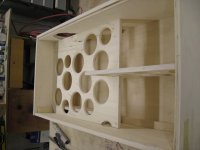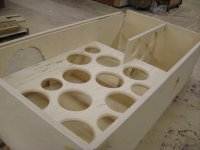Yea, I know. I've built a couple of crosscut sleds, but there is always been enough slop that the ends of a 4' board are not square. Close, but not square. I can get a 2'x2' piece square with the miter gauge ( my miter gauge has a 2' fence on it), but not 2'x4' pieces. The only issue then is the top and bottom of the sides, etc. This is where I make the crosscuts with a circular saw and then rip on the table saw.
I guess it's a matter of knowing one's limitations and developing techniques to get around them.
Bob
I guess it's a matter of knowing one's limitations and developing techniques to get around them.
Bob
No, but it would beat a "beaver by the tail" by a wide margin!!even a $150K Giben (et al) beam saw in perfect tune will only cut as accurately as the operator loads material (not all are auto-load)
(sorry, couldn't resist, Canada Day and all that
don
All crosscuts of the Pencil 12p can and will be done with my 10" Dewalt sliding compound mitre saw. Same applies for all critical crosscuts of the Super version, only two side panels are to long for the sliding compound mitre saw.
My issue is with the rip cuts on my contractor size Hatichi table saw, i don't trust it's 90º trueness. I may oversize them and use the router to true the cuts for butt joints.
Overkill but i'm thinking of using the biscuit joiner too in the assembly process.
My issue is with the rip cuts on my contractor size Hatichi table saw, i don't trust it's 90º trueness. I may oversize them and use the router to true the cuts for butt joints.
Overkill but i'm thinking of using the biscuit joiner too in the assembly process.
Well, let's just say it was short a 1/16" in all the wrong areas. Hahaha! In situations like it, it's best to just step back, use the scraps for another project, and move on. Also, fortunately with having a panel saw I don't need to worry about any cross cuts as it's all automated and just about as accurate as my CNC router. Onto the next one!
even a $150K Giben (et al) beam saw in perfect tune will only cut as accurately as the operator loads material (not all are auto-load)
That's when you switch from manual to automatic and let it cut to size for you. I never use fully manual on my beam saw for this very reason Trim an edge and let automatic cut it to size for ya.
You can use a tri-square/ framing square, to ensure the saw blade is @ 90 deg. to the table.All crosscuts of the Pencil 12p can and will be done with my 10" Dewalt sliding compound mitre saw. Same applies for all critical crosscuts of the Super version, only two side panels are to long for the sliding compound mitre saw.
My issue is with the rip cuts on my contractor size Hatichi table saw, i don't trust it's 90º trueness. I may oversize them and use the router to true the cuts for butt joints.
Overkill but i'm thinking of using the biscuit joiner too in the assembly process.
don
That's when you switch from manual to automatic and let it cut to size for you. I never use fully manual on my beam saw for this very reason Trim an edge and let automatic cut it to size for ya.
you might think I'm kidding, but if the sheets / cut parts aren't loaded square into the clamps, and the manufacturers' service reps can't get a technician to properly calibrate the side fence/ alignment rams or travel sensors, you're still at the mercy of the machine operator to catch the errors - true to dimension is one thing, but true to square on multiple cross cuts is rather another
yup, sometimes a decent table saw & rip fence are all ya need
Powertool dummy question - how is a sabre saw/jig saw for straight cuts of 3/4" and 1/2" material?
There are no dummy questions, but certainly some stupid answers.
With a well clamped straight edge and well locked in sharp blade you should be able to achieve a clean straight cut. I've never needed to, but I bet Bob has done his fair share on a balcony workshop.
All crosscuts of the Pencil 12p can and will be done with my 10" Dewalt sliding compound mitre saw. Same applies for all critical crosscuts of the Super version, only two side panels are to long for the sliding compound mitre saw.
My issue is with the rip cuts on my contractor size Hatichi table saw, i don't trust it's 90º trueness. I may oversize them and use the router to true the cuts for butt joints.
Overkill but i'm thinking of using the biscuit joiner too in the assembly process.
Rather than biscuits, if have a decent enough router, I'd take the extra time to cleat the rear panel and machine rabbets into the other 5 panels - makes for a much more glue surface area and a very well braced enclosure than biscuits.
Remember one guy's "Overkill" in another's "sure I guess that'd be OK for a quick n dirty"
Attachments
With a well clamped straight edge and well locked in sharp blade you should be able to achieve a clean straight cut.
I've done that. Fortunately not too many times.
dave
If you have a $100+ saber saw, you might get a clean accurate cut. When I was building speakers with a saber saw and hand tools, I always trued the cuts with a plane. Note that if you cut a curve with a saber saw, the blade will always lean to the outside of the curve. You cannot get a 90* cut with a saber saw.
I do use a saber saw quite regularly -- to rough out blanks to be finished on the router table.
Bob
I do use a saber saw quite regularly -- to rough out blanks to be finished on the router table.
Bob
You might be surprised how far out of square the average framing square is. Especially for a 36" to 48" cut. Same for the average triangle. If the framing square was that accurate, you'd have square walls/corners in your house.
You can use a tri-square/ framing square, to ensure the saw blade is @ 90 deg. to the table.
don
You do have a bit of a "router fetish", yes? 
Rather than biscuits, if have a decent enough router, I'd take the extra time to cleat the rear panel and machine rabbets into the other 5 panels - makes for a much more glue surface area and a very well braced enclosure than biscuits.
Remember one guy's "Overkill" in another's "sure I guess that'd be OK for a quick n dirty"These boxes definitely benefit from bracing, but it could be less elaborate than shown - those took longer to cut /fut than all the rest of the material for the boxes.
A framing square is used in this case to ensure the blade is @ 90 degrees to the table. The degree of error in such a short application is negligible. You can always check the square by scribing a line on some scrap,and reversing the square and checking again.You might be surprised how far out of square the average framing square is. Especially for a 36" to 48" cut. Same for the average triangle. If the framing square was that accurate, you'd have square walls/corners in your house.
BTW, the (inside) corners of SOME rooms are out of square because typically, a heavier application of drywall mud is applied to the corners.
(damn drywallers!)
Best
don
You might be surprised how far out of square the average framing square is. Especially for a 36" to 48" cut. Same for the average triangle. If the framing square was that accurate, you'd have square walls/corners in your house.
Or not!
I have a 4' drywall square,of all things, that is dead on. I use it to set my circular saw fence for cutting 4'x8's. But as previously stated, you can easily check this by drawing a line and the go to the other side and repeat the line. (I think that the assumption that the sides of a 4'x8' are parallel is generally valid. DO NOT assume the the ends are square with the sides though!)
Bob
You might be surprised how far out of square the average framing square is. Especially for a 36" to 48" cut. Same for the average triangle. If the framing square was that accurate, you'd have square walls/corners in your house.
dammit man you made me snort out my coffee - the out of true/plumb/square of wall framing has less to do with the accuracy / sophistication of the measuring tools than with the care & attention of the trades person - same could be said for speaker enclosures .
agreed Bob, the circular "skill" saw would be my first choice over jig saw for bucking to size - actually with a decent blade an clamped straight edge, they can be as clean and accurate as a table saw - just more work on repetitive cuts - and certainly don't assume that "4x8 ft" wood sheet goods are square or even consistently exactly same in all 3 dimensions
as for drywallers / mudders - yup Don, those are a special breed alright - just try to keep them out of the same work space/time as a floor layer or electrician
Last edited:
You do have a bit of a "router fetish", yes?
if referring to the photos with braces - actually the holes were cut with hole saw, and the rabbets with dado blade on table saw - only the chamfers by router
- Status
- This old topic is closed. If you want to reopen this topic, contact a moderator using the "Report Post" button.
- Home
- Loudspeakers
- Full Range
- StevenZ's Alpair 12P Build

